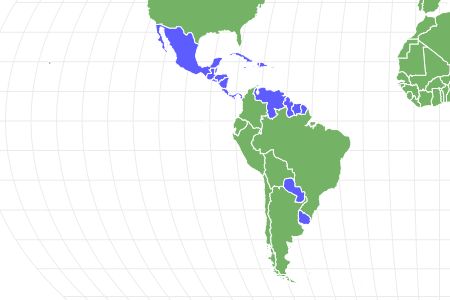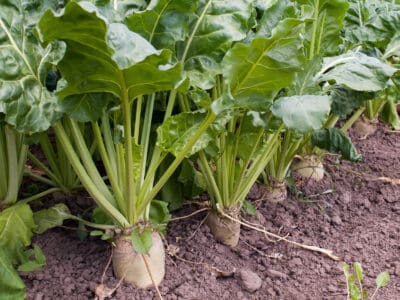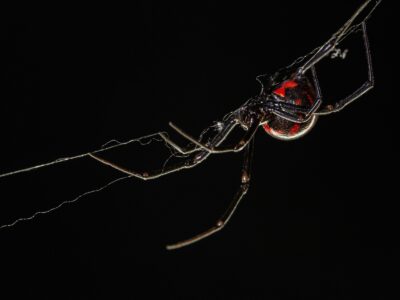Dwarf Boa
.jumbotron {
background-image: url(“https://a-z-animals.com/media/2022/05/dwarf-boa-suriname-shutterstock_1294336471-400×300.jpg”);
}
}
@media only screen and (min-width: 641px) and (max-width: 920px) {
.jumbotron {
background-image: url(“https://a-z-animals.com/media/2022/05/dwarf-boa-suriname-shutterstock_1294336471-470×370.jpg”);
}
}
@media only screen and (min-width: 921px) {
.jumbotron {
background-image: url(“https://a-z-animals.com/media/2022/05/dwarf-boa-suriname-shutterstock_1294336471.jpg”);
}
}
Dwarf Boa
Various
Some species can change color from dark to light, and back again.
Dwarf Boa Scientific Classification
- Kingdom
- Animalia
- Phylum
- Chordata
- Class
- Reptilia
- Order
- Squamata
- Family
- Boidae & Tropidophidiiae
- Genus
- Various
- Scientific Name
- Various
Read our Complete Guide to Classification of Animals.
Dwarf Boa Conservation Status
Dwarf Boa Facts
- Prey
- small mammals, birds, lizards
- Group Behavior
-
- Solitary except during mating season
- Fun Fact
- Some species can change color from dark to light, and back again.
- Biggest Threat
- In the wild, it’s habitat destruction
- Other Name(s)
- boa, dwarf boa, thunder snake
- Lifestyle
-
- Nocturnal/Crepuscular
This post may contain affiliate links to our partners like Chewy, Amazon, and others. Purchasing through these helps us further the A-Z Animals mission to educate about the world’s species..

Discover alligator-eating snakes, spiders larger than your phone, and 1000 more incredible animals in our daily FREE email.
.photo-gallery {
–margin: 0px auto 0px;
–padding: 0px 0px 0px 0px;
}
.gallery-link {
background-image: url(“https://a-z-animals.com/media/2022/05/dwarf-boa-hog-island-shutterstock_17693320-1024×614.jpg”);
background-repeat: no-repeat;
background-size: cover;
background-position: center;
height: 500px;
justify-content: center;
text-align: center;
align-items: center;
display: flex;
border: 2px solid #000;
}
.gallery-link img {
height: 50%;
}
@media only screen and (max-width: 768px) {
.gallery-link {
height: 300px !important;
}
}
View all of the Dwarf Boa images!
Dwarf boas can be a fantastic option for those who want a snake, but not a behemoth.
Boa species range from truly tiny to gargantuan, and some of the most beautiful species are gentle and calm, making them great pets – if you have the space. However, many of us don’t have enough space or the desire to have a buddy help us handle our 14-foot pet boa.
Meet the dwarf boas.
button.pulse {
transform: scale(1); animation: pulse 2s infinite;
box-shadow: 0 0 0 0 rgba(11, 247, 25, 1);
}
@keyframes pulse {
0% { transform: scale(0.90); box-shadow: 0 0 0 0 rgba(11, 247, 25, 0.5); }
60% { transform: scale(1); box-shadow: 0 0 0 15px rgba(11, 247, 25, 0); }
100% { transform: scale(0.90); box-shadow: 0 0 0 0 rgba(11, 247, 25, 0); }
}
They can be of a naturally occurring smaller locality of Boa imperator, one of the Tropidophiidae dwarf boas, or a species that was bred to be smaller for owners who want the boa experience without the bulk.
Amazing Facts About Dwarf Boas
- Tropidophiidae family snakes aren’t boas, per se, but they look like boas.
- Some dwarf boas were deliberately bred smaller, and others are naturally occurring in different localities.
- Many can change colors from light to dark, and back again.
Where to find a Dwarf Boa
Those dwarf boas that were bred down in size are fairly easy to find from breeders. They tend towards the expensive end of the hobby, as they were specially bred for size, but they’re excellent choices for those who want a big snake that won’t get too big.
Naturally occurring dwarf boas, such as those found in the Tarahumara region of Mexico, the Islands near Panama, and other areas. Some are being captive-bred in the U.S., so finding one of these for your next snake pet is possible without taking one from the wild. Often, these snakes live in areas where small sizes were rewarded by nature. It’s usually caused by limited prey and a lack of appropriate cover.
The Boa look-alikes from the Tropidophis genus aren’t as readily available. Plus, given that many are endangered or threatened in nature, their focus should be on preserving those species. They also tend to be more delicate than their larger dwarf cousins. These snakes generally inhabit areas of South America and the West Indies; most species spend their day either hidden under vegetation or burrowed underground. They only surface at night and when it rains. A few arboreal species hide in the bromeliads that grow on trees.
Dwarf Boa Scientific Name
Dwarf boas aren’t one species of snake, they’re a class of boas and boa-like snakes that stay smaller than you expect from a boa. There are types of dwarf boas, we list a few here:
Boa Imperator and Candoia Locality Dwarf Boas
This is what many people mean when they’re talking about dwarf boas. These are true boas that stay small because of the ecological niche that they inhabit in the wild. Corn Island boas, Caulkers Cay, Crawl Cay, Belize Mainland, and Hog Island boas are all subgroups of Boa Imperator. They aren’t generally considered subspecies, although some could possibly qualify. This species typically grows much larger – sometimes as long as 14 feet. However, because the prey is scarce, or the hiding spaces are small, only the small survive in their environment.
Sometimes, when brought into a pet situation, a dwarf locality gets much bigger than expected. Why? Well, when you have a growing reptile that’s been accustomed to a particular amount of food, its body adjusts to that. It grows to fit its environment. Now, remove it from that environment and give it more food and better habitat. It’s going to get bigger than it would have in its native habitat, which makes the husbandry of these dwarf boas more challenging than that of other boas.
Boa Constrictor or Boa Imperator Dwarf Snakes Created by Breeders
These snakes happened to carry a dwarfism gene that a breeder decided to explore. They’ve become popular because they naturally stay much smaller than their “standard” cousins (and even some of the dwarf locality boas). These snakes typically only reach about 4-6 feet and look like a smaller version of the regular B. imperator or B. constrictor.
Tropidopidiiae – the Boa Look-Alikes
At one point, this family was included in the Boidae family because they look like boas, but newer research indicated they are more closely related to false coral snakes than boas. So, out of the Boidae, and into Tropidophidiiae they went.
There are two genera in this family and 19 species between them. They’re very secretive and difficult to observe. A few are in zoos but because they’re not as flashy as say, a rainbow boa or an anaconda these little guys just don’t get the public play that the true boas get.
Population and Conservation Status of Dwarf Boas
Many Tropidophis genus snakes have been assessed by IUCN and found to be Vulnerable or Endangered, but a few are classified as Least Concern. One or two haven’t been seen in over 100 years and are assumed extinct. The highly secretive nature of the genus makes them exceedingly difficult to study.
The dwarf boas bred deliberately by breeders aren’t out in nature, so there’s no assessment available. These snakes are strictly pet-trade animals, and that’s a beautiful thing – it allows snake lovers to have a boa in a small package, and doesn’t deplete the wild population.
The locality dwarfs, though – now there’s a good question. You could think of localities as nature’s version of a morph because they’re shaped by their environment. At this point, most locality boas have either been studied or are being studied and conservation is helping their population, like the Hog Island Boa. IUCN doesn’t list any of them as separate species from Boa constrictor, but some localities are endangered because of pet trade exportation and habitat destruction.
There are a couple of locality dwarf boas from the Solomon Islands, they belong to the Candoia genus. These snakes are pretty stocky and spend a lot of time on the ground; they’re bred in captivity, but quite expensive when you find them.
Identifying Dwarf Boas: Appearance and Description
Because of the wide variety of dwarf boas both available as pets and out in the wild, the descriptions vary significantly.
Even the dwarf boas tend towards being heavy-bodied and muscular. However, due to their overall size, they’ll be a bit thinner than typical boa constrictors. Some species change color from night to day, becoming darker and lighter. These snakes are nonvenomous constrictors that grab prey with rear-pointing teeth and squeeze until the prey’s heart stops. Then, they swallow it whole.
The Tropidophis genus dwarf boas are much more slender and fragile. Many of them change color depending on the time of day, and can even bleed voluntarily from the eyes, nostrils, and mouths when threatened.
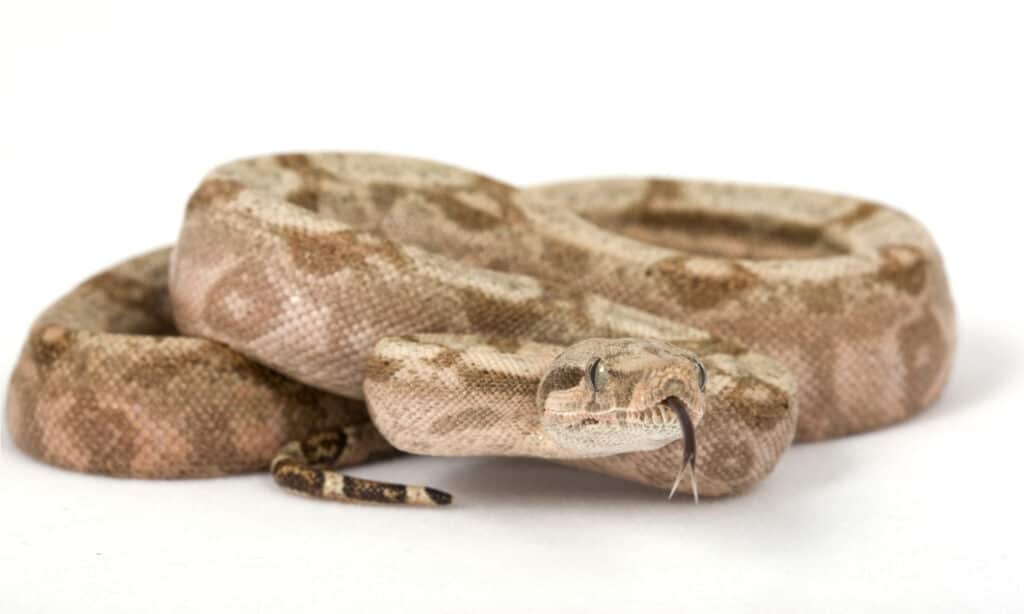
fivespots/Shutterstock.com
Pictures and Videos of Dwarf Boas

fivespots/Shutterstock.com
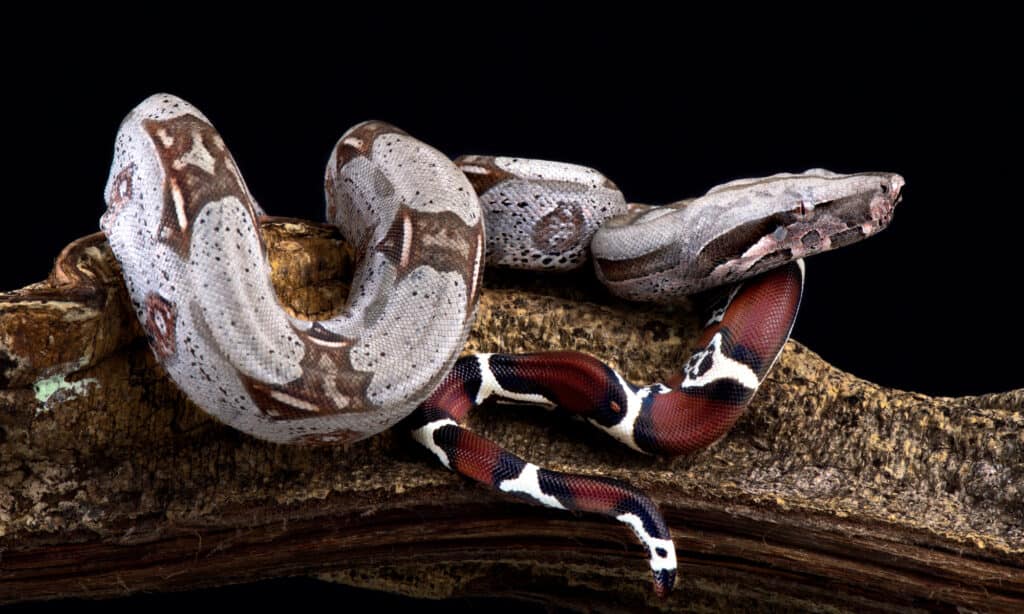
reptiles4all/Shutterstock.com
How Dangerous are Dwarf Boas?
A dwarf boa isn’t as difficult or dangerous to handle as a full-size red-tailed boa because it’s small. Its teeth may make you bleed, but otherwise, you won’t suffer any ill effects from a bite. The wonderful part of any of the dwarf boa species is that they are small enough to handle relatively easily, they move slowly enough that you’re not going to be chasing it off across the yard, and they’re nonvenomous.
Dwarf Boa Behavior and Humans
Dwarf boas are relatively easy to handle. They’re not aggressive snakes, but some boas can be a bit bitier than other snake species. Like many animals, each snake has a different personality; they even have different moods.
Dwarf locality boas from the Boa and Candoia genera make pretty good pets – if you are willing to take the time and money required to create a great habitat for them, proper feeding amounts, and learn to read their moods.
View all 62 animals that start with D
Dwarf Boa FAQs (Frequently Asked Questions)
What is the most popular pet dwarf boa?
Most of those available as pets were bred specifically as small versions of either Boa constrictor or Boa imperator. The others aren’t as readily available and are more difficult to keep.
Where do dwarf boas live?
The naturally occurring variations inhabit areas of the West Indies, Central, and South America.
What do they eat?
Dwarf boas eat anything from small lizards and birds to eggs and mice.
How do dwarf boas hunt?
Most are ambush predators, but a few take a more active approach and forage for their prey.
Sources
- Tarahumara Mexico Boa | Bowling Green State University, Available here: https://www.bgsu.edu/arts-and-sciences/biological-sciences/facilities-and-resources/bgsu-herpetarium/animals/reptiles/tarahumara-mexico-boa.html
- Dwarf Boa Care and Feeding | Tim’s Reptiles, Available here: https://www.timsreptiles.co.za/uncategorized/dwarf-boa-care-and-breeding
- Dwarf Boa Husbandry, Available here: http://tcreptile.com/pearl-island-panama-boas/
- Reptile Database, Available here: https://reptile-database.reptarium.cz/advanced_search?taxon=Tropidophiidae&submit=Search
- (1970)

